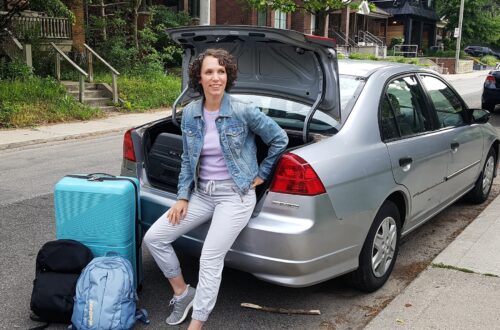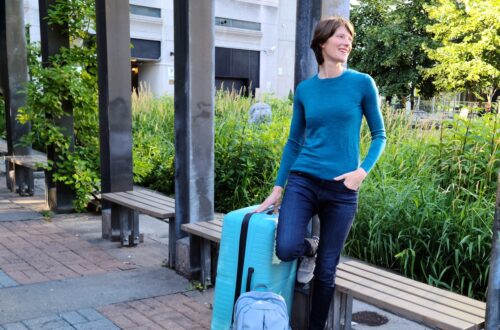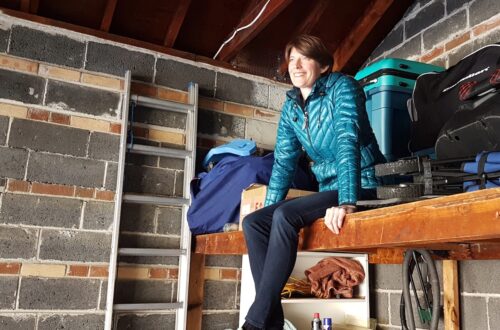
How To Get Rid Of Everything You Own To Travel
Preparing for the Slow Travel Lifestyle
Today we are officially homeless. Around six months ago, we said goodbye to Singapore where we had been living as expats for over six years and embarked on a lifestyle of slow travel. We left our rented apartment with two large suitcases, two knapsacks and two dogs. We have to carry almost everything we own, with the exception of some clothes, mementos and photo albums in a 5 x 5 foot storage locker in Toronto, Canada.
But just prior to our big exit from holding corporate jobs, we owned a normal amount of stuff spread across a two-bedroom apartment in Singapore and a 5 x 10 foot storage locker in Canada. So how did we go from owning a regular amount of consumer goods that accumulate over many years — including furnishings, small appliances, pots and pans, bedding, decorative items, sports equipment, paperwork — to leading a minimalist nomadic life where we’ve said goodbye to 95% of our possessions?
Why get rid of almost all our possessions?
First, we can tackle the question of why…why we would want to downsize almost all of our possessions. When we realised that we would be able to achieve financial independence and retire early from our corporate jobs, the next decision to make was how we would live the next stage of our lives.
After much discussion, we agreed on a shared vision of traveling the world full time, something that we were both very passionate about. We agreed that we wanted to see as much of the world as possible, which prior to early retirement we had attempted to do in one to two-week vacation increments. We talk more about the process of coming up with a vision and a plan in this video:
We quickly realised that this lifestyle called for minimal possessions, especially since we had no need to maintain a household in any one country. All we needed was the smallest possible storage locker for items too precious to give away or sell. Everything else had to go.

How we were able to downsize by 95%
In fact, our earliest wave of downsizing started six year prior with our move to Singapore. We put most of our household goods into storage, got rid of the rest and then moved overseas into a furnished apartment with just our personal effects. Once we realized that Singapore would be our home for the foreseeable future, we moved all our best possessions from Canada, which was enough to fill a two-bedroom apartment. The rest made its way to donation bins.
However, it was only when we got serious about chasing our financial independence goals that we also started downsizing in earnest. The first step was moving from an expensive two-bedroom condo into a much cheaper studio apartment.
The move was primarily motivated by the cost savings we could achieve but we quickly discovered that it also forced us to re-evaluate all our possessions. The smaller apartment only had limited storage so whatever didn’t fit had to go. This was a happy development for us as we had always been minimalists at heart and now we were paring down to only those things we really wanted to live with.
Once we decided on our post-financial independence plan of full-time travel, the downsizing truly accelerated. We were fortunate to have a very sophisticated peer-to-peer buying and selling platform in Singapore called Carousell. As we moved closer to our departure date, our activity of posting items for sale on Carousell spiked.
We were posting new items for sale every couple of days, conversing with buyers hourly and having meet ups to handover goods most evenings and weekends. We sold over 200 items — everything from kitchen goods worth only a couple dollars to large furniture worth hundreds. By the time we were ready to leave Singapore, our apartment was empty except for a few boxes to be shipped back to Canada.
What we learned
Selling or donating almost all of our possessions was a once-in-a-lifetime experience and we learned a lot about ourselves and our relationship with material goods.
First, it was a very humbling process to attempt to sell items that were precious in our eyes — whether based on their original purchase price or for emotional reasons — and discover that the market wasn’t interested except at rock bottom prices. Those items may have meant a lot to us at one point but they meant very little to our potential buyers. Even when an item was not attracting any buyers on Carousell, we agonised over lowering the price. After all, just think of how much we originally paid.
We also discovered that it is generally easy to accumulate stuff but it is very hard to get rid of it. Even while we lived in a studio apartment, we found that our possessions kept expanding. There always seemed to be another need that could be solved by buying something. And yet while it was easy to buy stuff, it was very difficult to sell it.
All of this taught us that we needed to be more thoughtful about future purchases. Now that we have to carry everything we need as long-term travelers, each potential purchase needs to be carefully considered before it can be added to our already-full suitcases, which we discuss further in this video:
Fortunately, after this long, emotionally draining experience, we feel a sense of freedom and relief. We now feel that we can eventually make a home anywhere in the world; we’re not limited by where our possessions are situated. We don’t have to return to Canada when we want to settle simply because our living room set is based there.
We also have a sense of starting fresh. Many of our material possessions came with a long history attached — often one that was out of proportion with the value the item currently offered. For example, we had a lot of decorative glassware given as wedding presents over a decade before from people who certainly wouldn’t remember what they gave us. It was more important to ensure a good relationship with those people today versus holding onto a serving dish for years and years.
If you’re interested in financial independence and early retirement, click here to subscribe to our YouTube channel.





7 Comments
Pingback:
Pingback:
Pingback:
Pingback:
Neil Mitchell
This is all very prescient for us at the moment. We accepted an offer on our house a week ago and we need to move out in 6 weeks. We have a four bedroom house with everything that you tend to accumulate over a 20 year period of marriage.
How we value things is all very upside down. Until a time like this, I have things such as my record collection, that I would never have considered selling, in fact, I have always told my wife to bury me with it when that day comes :-). But now I am coming to sell, I am not finding it as difficult as I thought, with every item that goes, I feel lighter! I think that getting to the point where you only own what you need, must be an amazing and freeing feeling. We can’t wait to get there. There are the odd things that we will keep and store with family, but if that takes more than 2sq metres, I think we will have failed.
Thanks for sharing, as usual… top notch content. Keep up the good work!
Neil
Our Freedom Years
Hi Neil – Wow, what an exciting juncture you’ve reached. Downsizing is not easy and we certainly went through a lot of mixed emotions during the process. Now that we are down to a couple suitcases plus a few boxes of mementos in storage with family, we certainly do feel light and carefree on the road. We wish you all the best as you move one step closer to your new life of travel!
Pingback: